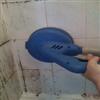

2005-2010 www.groutclinic.com. All rights reserved.
Sealing The Grout Of Your Floor
Spring Cleaning

REVIEWS
Highly Recommend
By Jan - Dec 10, 2009
excellent job cleaning and sealing the ceramic tiles on our main floor. My husband and I were both amazed at the difference. We considered trying to clean the grout ourselves because we thought the cost was a bit high to hire some. But after seeing the the amount of work involved, we felt we were getting a bargain! It only took a few hours to do the entire job whereas it would have taken us weeks and it would not have come out as nice. I found that was a pleasure to deal with. He was honest, prompt and courteous. I would highly recommend him to my friends and family.
maps.google.com
Amazing Job?
By richard - Dec 7, 2009
I highly recommend . He is the nicest person to deal with and he saved me thousands of dollars because I was about to change the floor. The floor looks brand new and my shower looks fabulous. It was so grungy before. He is a magician and I highly recommend him.
maps.google.com
20 year old bathrooms never looked so good!
By vicki.blake - Dec 4, 2009
Grout Clinic cleaned and re-grouted 5 bathrooms in my century home. The bathrooms are over 20 years old and they look new. It's incredible. The owner is so professional and courteous and such a hard worker. It was a pleasure to have him in my home.
Tile and grout areas are the breeding grounds for bacteria .
There is a potential for MRSA ( Methicillin-resistant Staphylococcus aureus) eliminating the germs,toxins, and bacteria that can cause infection can be done by thorough cleaning.
Sealing The Grout Of Your Floor
Spring Cleaning
416-829-4145
Serratia marcescens is a species of Gram-negative, rod-shaped bacterium in the family Enterobacteriaceae. A human pathogen, S. marcescens is involved in nosocomial infections, particularly catheter-associated bacteremia, urinary tract infections and wound infections, and is responsible for 1.4% of nosocomial bacteremia cases in the United States. It is commonly found in the respiratory and urinary tracts of hospitalized adults and in the gastrointestinal system of children.
Due to its ubiquitous presence in the environment, and its preference for damp conditions, S. marcescens is commonly found growing in bathrooms (especially on tile grout, shower corners, toilet water line, and basin), where it manifests as a pink discoloration and slimy film feeding off phosphorous containing materials or fatty substances (such as soap and shampoo residue). Once established, complete eradication of the organism is often difficult, but can be accomplished by deep cleaning .
Athlete's foot is caused by the ringworm fungus ("tinea" in medical jargon). Athlete's foot is also called tinea pedis. The fungus that causes athlete's foot can be found on many locations, including dirty grout and tile on floors in gyms, locker rooms, swimming pools, nail salons, and in socks and clothing. The fungus can also be spread directly from person to person or by contact with these objects.
Onychomycosis is a fungal infection of the finger or toe nails which is very difficult to cure.
II. Causes:
Onychomycosis is caused by a fungus. Often a person has had athlete's foot for a long time prior to the development of onychomycosis.
Sometimes trauma or damage to a nail predisposes to the development of onychomycosis.
Plantar warts are spread by contact with moist walking surfaces, they can be prevented by not walking barefoot in public areas such as showers or communal changing rooms, not sharing shoes and socks, and avoiding direct contact with warts on other parts of the body or on other people.
WHAT IS MILDEW?
Mildew is a type of fungus that be found growing on a multitude of surfaces where moisture and temperature levels are high. Mildew can be identified and distinguished from other types of fungi by its thin, sheet-like appearance that often coats entire surfaces. Mildew can be black or white in color. As mildew grows, it leaves behind a musty, sour-like odor. Most mildews are caused by an overgrowth of it's close cousin, mold. In the home, mildew can grow on most types of fabric, leather, wood, paper, cement, linoleum, paint, sheet rock, and more.
CAUSES OF MILDEW
The most common causes of mildew include:
Poor cleaning
Poor air circulation.
Low or non-existent lighting.
Warm, humid temperatures.
Grease or body oils left on materials, such as shower walls and doors.
Damp or wet conditions.
BATHROOM MILDEW
While you may head to the bathroom
to get clean, bathrooms are most often the dirtiest and most bacteria infested rooms in the house. Due to their small size, mixture of surfaces, and the fact that they generate tremendous amounts of moisture and humidity, the bathroom is a natural breeding ground for all types of bacteria and mildew. White and black mildew often shows itself in bath areas by clinging to walls and ceilings, growing on shower doors and curtains, and spreading between grout and tile.
